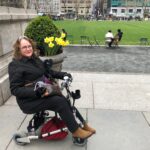 Assuming that you may not know what post-polio sequelae involves, I’ll tell you briefly, because fatigue is the primary aspect that nearly all polio survivors experience, even if they never had paralysis (which most polio patients did not). I have had a mostly paralyzed leg and fully paralyzed foot for 72 years, for my part.
Assuming that you may not know what post-polio sequelae involves, I’ll tell you briefly, because fatigue is the primary aspect that nearly all polio survivors experience, even if they never had paralysis (which most polio patients did not). I have had a mostly paralyzed leg and fully paralyzed foot for 72 years, for my part.
What happens with this syndrome is not agreed upon by all doctors, of course, but it seems that about 30 to 50 years after the original onset of polio, survivors experience new weakness, pain and fatigue. Some people thought this was a recurrence of polio, but it’s generally thought that since the polio virus when a patient first contracts it always kills at least a few but often many motor neurons, and neurons naturally wear out as everyone ages, we just have fewer operative motor neurons to help us move muscles. Hence, when we are physically active, it takes us far longer to recover, and sometimes we don’t recover at all. So walking a block could take a few minutes, and at the end of it, if we make it that far, we need to at least lean against a lamppost if not sit down, for usually the same amount of time it took to walk that block.
Over and over all day long. One reason I stay home a lot. Distances in the house are short and there are lots of chairs!
Misdiagnosis of polio survivors has been rampant, given how few doctors are alive who are familiar with it, and sometimes too much exercise has been prescribed, especially if the patient didn’t recall or know he or she had had polio. There is exercise needed to maintain muscles but it has to be very specifically prescribed. Most of the younger polio survivors live in India, Afghanistan, Pakistan and other countries that didn’t have the vaccine as early as the US did. So, ironically, the US has few polio knowledgeable doctors.
So what we are taught by therapists with correct awareness when this PPS starts setting in is “brace and pace, and manage the number of tasks you THINK you can do in a day, because it’s probably less than that.” We start wearing things like ankle or knee braces and using crutches, canes and walkers. I now embrace assistive devices. I am so thankful for my mobility travel scooter.
And when I plan my calendar, I know that more than two events (even a zoom) in a day are pretty much impossible, and keeping it to one or less is wise.
My pool exercise has assisted me first in gaining a little strength (20+ years ago when I started it), and showing me that I had a limit (I got to a point where I was doing too much and risking loss of strength) and now I’m in the sweet spot. I know how much is beneficial and how much is too much, so I don’t ever go there anymore.
I know that many of you know exactly how this is, dealing with fatigue. It may be far worse for you, even without any paralysis.
One continues to hope that someone, someday, will put their finger on the fatigue cure… not that there is a one size fits all. It truly depends upon the condition causing it, and at the same time, every polio survivor, for instance, is different. I have been sorry to read in a recent The Atlantic article by Ed Yong (7/27/23) that some long Covid people have worse problems with fatigue than I do.

Leave A Comment